The Calixtlahuaca-Tecaxic “Roman Head” was discovered by José Garcia-Payón in 1933 whilst excavating a burial site within the Matlatzinca city of Tecaxic (now named Calixtlahuaca). The Roman bust was found amongst a cache of offerings, including gold, turquoise, crystal and pottery, buried three floors beneath a sacred pyramidal structure. The burial site appeared undisturbed and dates between 1476 and 1510 AD. This means the piece must predate the Spanish conquest, which didn’t reach the shores of Mexico until 1519. So how did a “Roman” figurine head find its way into a pre-Columbian burial?
In 1995 the head was sent to Germany for scientific thermo-luminescence testing by Forschungsstelle Archäometrie. The results they provided gave a production date between 184 BC and 616 AD, which proved it is much older than the grave it was found within and could have been taken to the Americas in very ancient times. The date of production was further narrowed by classical historian Ernst Boehringer, who identified the piece as being stylistically in keeping with Roman artwork of the 2nd and 3rd centuries AD. This was further narrowed to the 2nd century by Bernard Andreae of the German Institute of Archaeology in Rome, who stated:
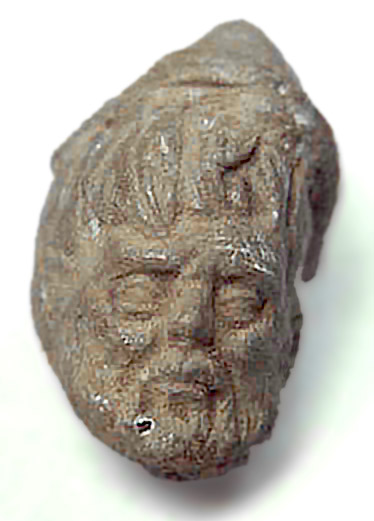
Roman Head found at Calixtlahuaca “[the head] is without any doubt Roman, and the lab analysis has confirmed that it is ancient. The stylistic examination tells us more precisely that it is a Roman work from around the 2nd century A.D., and the hairstyle and the shape of the beard present the typical traits of the Severian emperors period [193-235 A.D.], exactly in the ‘fashion’ of the epoch.”
Assuming, then, that the head is authentic, the most convenient answer on how it found its way into the grave is that it was planted there. The site was undisturbed and it is extremely unlikely that robbers would break into a grave and deposit even older and more valuable artefact, so the only opportunity to introduce the head would have been during the excavation – as a hoax. Following Romeo H. Hristov and Santiago Genovés’ 1999 publication on the Calixtlahuaca Roman head, a researcher named Paul Schmidt from the lnstituto de lnvestigaciones Antropologicas at UNAM, Mexico City, claimed exactly this in an informal letter in which he wrote:
“…the figurine was planted in Don Pepe’s [José Garcia Payón’s] dig, the saying goes, by Hugo Moedano. Don Pepe took it so seriously that no one had the heart to tell him it was a joke. This I remember having been told by John Paddock….Taking into consideration Hristov’s known unethical behavior and the obvious controversy which would result from the publication, I find it extremely hard to believe that two of the three serious and professional referees … would support the article.”
However, nobody present during the excavation was alive to verify or deny the controversial claim, and no-one else connected with research of the site recalls any such claims being made. Payon’s son stated that Moedano hadn’t even been present at the excavation site. So, although Schmidt’s argument is the most logical, there is no evidence that there is any truth in it.
If it was not a modern introduction as a hoax, then it had to be introduced at the time of the burial and before the arrival of Europeans on the mainland. This is possible, because although the Conquistadors did not reach the Mexican mainland until 1519, the nearby islands of the Caribbean had been colonised since the late 15th century, and Columbus’ parties had also reached mainland coastal regions from Honduras to Panama. So it is possible that the piece was brought from Europe and traded with the indigenous population and then the piece travelled via trade networks all the way to Calixtlahuaca. Whilst this would explain how a small Roman bust could have found its way to the burial site, it does also raise the inexplicable questions of why a Spanish colonialist or explorer would take a small 3rd century Roman head with them to trade and why an Aztec nobleman would choose it to accompany them to the afterlife.
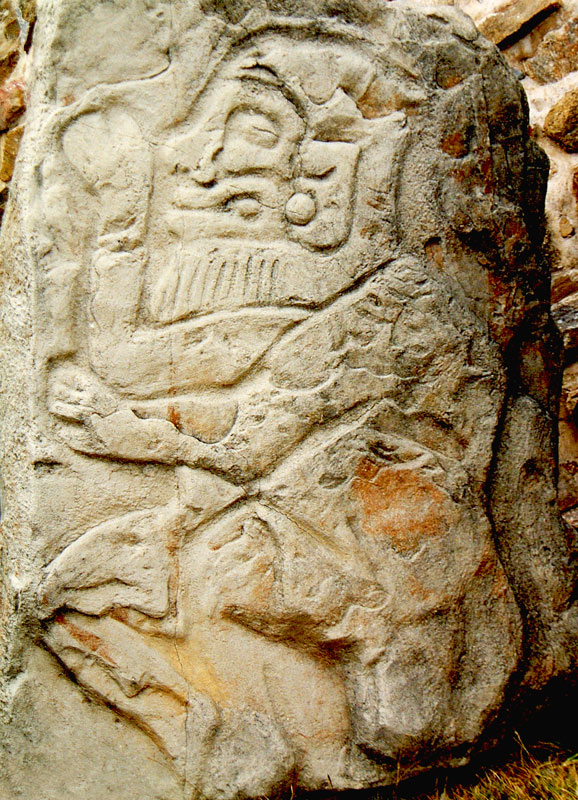
Monte Alban – Bearded ManThe answer to the latter question is that although it looks like a 3rd century Roman Emperor, and possibly is, there are plenty of pieces of Mesoamerican artwork that feature European or Persian looking bearded men and were highly revered. The ancient Olmec civilisation were particularly keen at creating foreign looking figurines – epitomised be their most famous pieces, the huge African looking Olmec heads. Other civilisations of middle Mesoamerica, such as the Zapotec, frequently used imagery of bearded foreign looking men. This region is also home to a city called Comalcalco, which appears to have been built using Roman techniques. In the north, the Toltec claimed their civilisation was founded by a God named Quetzalcoatl who was a bearded white man – or least this is what the Aztec ruler, Moctezuma II, allegedly told Cortes and his party of Conquistadors when they arrived. So there is actually some evidence to suggest an Aztec nobleman would bury a Roman head with them.
The question then rests on whether the head was manufactured by Romans, or whether it just looks Roman and was actually the imaginative work of a Mesoamerican artist. With Roman and Greek sailors reaching the Canary Islands and being such keen explorers, it is almost certain that they would have tried to 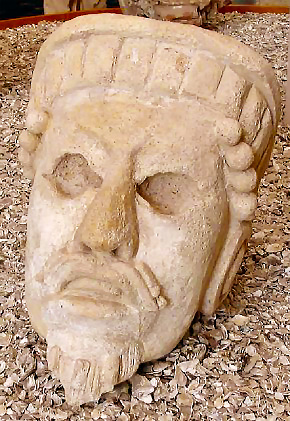
Comalcalco – Bearded Manexplore further west, but the lack of written accounts in Roman Europe suggests they never succeeded on the return journey. Of course, this doesn’t prove that Romans never landed in the Americas and the only way to answer this question is to find Roman artefacts and evidence of their influence in artwork and architecture within the Americas. Unfortunately, the Roman head of Calixtlahuaca is not conclusive evidence of Roman contact because the archaeology surrounding its discovery is not sufficiently robust – the documentation is massively deficient with a total lack of photography, the absence of drawn plans of the excavation and no drawings of the piece on discovery or the stratifigraphic context of the find. However, it cannot be discounted either and should be added to the ever increasing list of uncertain anomalies that suggest there was ancient contact between the Old World and the New.
The Calixtlahuaca Roman Head is held at the National Museum of Anthropology in Mexico City, where it is archived as a Colonial piece.
References:
http://www.faculty.ucr.edu/~legneref/romeo/romanhea.htm
http://www.unm.edu/~rhristov/calixtlahuaca.html

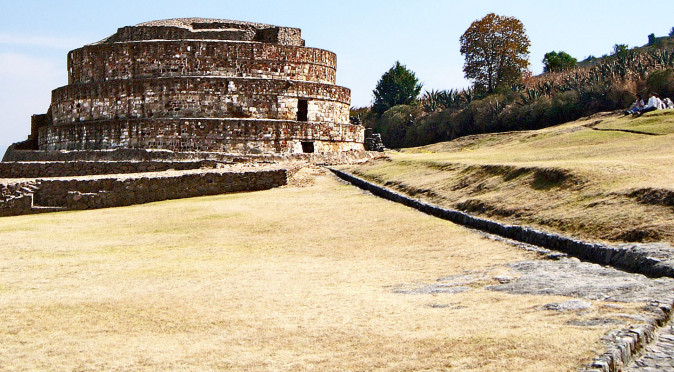
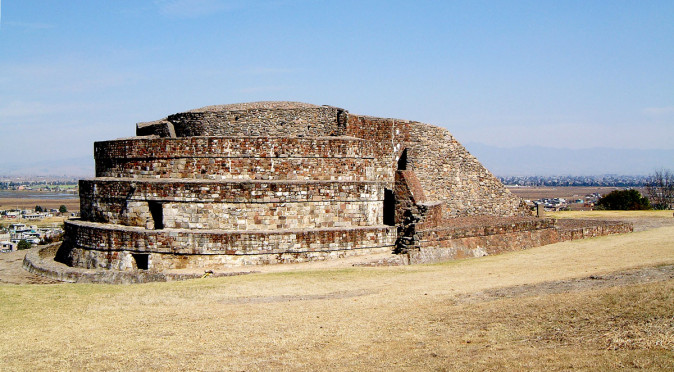
Have they had a test on the stone?
From which sort it is? Local?
In Peru there are bearded images to. Even some old Inca stories tell about the coming of the Bearded people.
If you google Chavin de Huantar, you see similarities like those ‘clavos’ that is translated as nails. Heads of Puma or Jaguars encrusted in the walls, same as here.
Similarities in art you can find in the sacrifice stone knife.
Olmec’s might be from the Western islands. Like Papua or Australian aboriginal folks, even Sri Lanka type of faces. (Lemur?)
The round shape is very strange as i recall just few, one is Cuicuilco. Makes me think of British islands circle shaped burial sites or temples.
Mysteries everywhere.